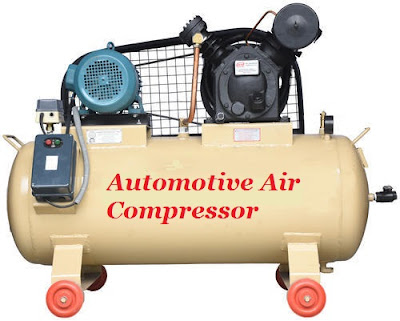Air Compressor and function
Air
Compressor
An air compressor is a machine that converts power (using an electric motor, diesel or gasoline engine, etc.) into potential energy stored in pressurized air (i.e., compressed air). By one of several methods, an air compressor forces more and more air into a storage tank, increasing the pressure. When tank pressure reaches its upper limit the air compressor shuts off. The energy contained in the compressed air can be used for a variety of applications, utilizing the kinetic energy of the air as it is released and the tank depressurizes. When tank pressure reaches its lower limit, the air compressor turns on again and re-pressurizes the tank.There are many methods of air compression and can be divided into either positive-displacement or negative- displacement type compressors.
Positive
Displacement
Positive-displacement
compressors work by forcing air into a chamber whose volume is
decreased to
compress the air. Common types of positive displacement compressors
are:
● Piston-type
air compressors
● Rotary
screw compressors
● Vane
compressors
Piston-type
air compressors type of air compressors uses the principle in which
pumping of air into
an air chamber takes place because of the use of constant motion of
pistons. They use one way valves
to guide air into a cylinder chamber, where the air is compressed.
Rotary
screw compressors use positive-displacement compression by matching
two helical screws
that, when turned, guide air into a chamber, whose volume is
decreased as the screws turn. Vane
compressors use a slotted rotor with varied blade placement to guide
air into a chamber and compress the volume. Vane compressors deliver
a fixed volume of air at high pressures.
Negative
Displacement
Negative-displacement
air compressors include centrifugal compressors. These use
centrifugal force generated by a spinning impeller to accelerate and
then de-accelerate captured air, which pressurises
it.Compressors
can also be classified according to the type of pressure:
● Low-pressure
air compressors , which have a discharge pressure of 150 psi or less.
●
Medium-pressure
compressors, which have a discharge pressure of 151 psi to 1,000 psi.
●
High-pressure
air compressors which have a discharge pressure above 1,000 psi.
Working
principle of Air Compressor
Air
compressors collect and store pressurized air in a tank, and use
pistons and valves to achieve the appropriate pressure levels within
an air storage tank that is attached to the motorized unit. There are
a few different types of piston compressors that can deliver even air
pressures to the user.
Automotive
compressors are combustion engine compressors that use the
up-and-down stroke of the piston to allow air in and pressurize the
air within the storage tank.Other piston compressors utilize a
diaphragm, oil-free piston. These pull air in, and pressurize it by
not allowing air to escape during the collection period.
These
are the most common types of air compressors that are used today by
skilled workers and craftsmen. Before the day of motorized engines,
air compressors were not what they are today. Unable to store
pressurized air, a type of antique air compressor may be found in the
blacksmith’s foundry bellows. Now the air compressor is capable of
building extreme pressures in storage tanks capable of storing
enormous amounts of pressurized gases for industrial use.
Applications
of Air Compressor
● Portable
air compressor for powering tools, such as jack-hammers.
● To
supply high-pressure clean air to fill gas cylinders.
● To
supply moderate-pressure clean air to a submerged surface supplied
diver.
● To
supply moderate-pressure clean air for driving. Some office and
school building. pneumatic HVAC control system valves.
● To
supply a large amount of moderate-pressure air to power pneumatic
tools, such as jack-hammers
● For
filling tyres
● To
produce large volumes of moderate-pressure air for large-scale
industrial processes (such as oxidation for petroleum coking or
cement plant bag house purge systems). Most air compressors either
are reciprocating piston type, rotary vane or rotary screw type.
Centrifugal compressors are common in very large applications. The
power of a compressor is measured in HP (Horsepower) and CFM (cubic
feet of air per minute). The gallon size of the tank tells you how
much compressed air “in reserve” is available. Gas/diesel powered
compressors are widely used in remote areas with problematic access
to electricity.They are noisy and require ventilation for exhaust
gases. Common workshop/ garage compressors are 110-120 Volt or
230-240 Volt. Compressor tank shapes are: “pancake”, “twin
tank”, “horizontal”, and “vertical”. Depending on a size
and purpose compressors can be stationary or portable.




It was great reading you blog post. You have mentioned everything very point to point. When i was searching for the answer i am very much curious to know how things work but after reading your post all my doubts about this got cleared. I got my answer by reading your post. Keeping posting stuff like this future. I will look forward to your post.
ReplyDeletemedicalequipment
when you have dumps with the pin, that means you virtually have the real-life access of the physical credit card. That’s exciting, right? ccv dumps ++ Visit our shop dumps to see all the dumps track 1 and 2 with Pin ++
ReplyDeleteThis is very nice information, Thank you so much for sharing your knowledge. Screw Air Compressor
ReplyDelete